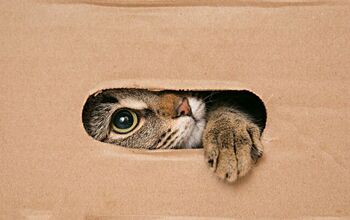The Dangers of Pets Eating Protective Face Masks

So, you’ve just finished off that juicy burger and fries and now it’s time to head back indoors. Naturally, you squirt a little hand sanitizer onto your palms, rub it in, and put your mask back in place. What’s wrong with this picture? Nothing, as long as you realize that your paper (or fabric) mask just acted like the mother of all napkins by absorbing little bits of grease and that oh-so luscious smell of fries. And guess who loves all of that (other than you, clearly)? Your pooch.
Now for anyone who has a dog that loves to raid the garbage on the off-chance that the faint whiff of last night’s dinner might actually net him something delish, you already know what happens when he fixates on something. He becomes the proverbial “dog with a bone” and won’t let up until he’s sourced that smell. And what this means is that when you get home and peel off that yummy scented mask, your best buddy considers it up for grabs and his project for the evening. The lesson here: never assume that because it isn’t food, it isn’t something he’ll try to eat.
Because we now realize that personal protective equipment (PPE) is likely going to be around for a while, its probably time to come up with a game plan for not only where to safely stow both paper and fabric masks, but how to keep Rover from deciding they’re something he wants to scarf down.
So, consider:
- Opting for reusable fabric masks. While your dog may still think they smell pretty edible, it’s less likely a smaller pooch will try to wolf down something quite so bulky. And if he does choose to consume, the fabric versions don’t have metal attachments that can damage his digestive tract. It still needs to come out, but it won’t cause puncture injuries.
- Placing masks and hand sanitizers up and out of reach of all pets (yes, cats can get in on this action too). Make it a habit – like dropping your keys and change in the same spot each evening. Masks come off and get tucked into a dedicated drawer or up onto a high shelf.
- Washing them frequently. Even a quick hand wash in the bathroom sink can help remove residual food odors and make them less appealing for your pooch. And, quite frankly, make them more appealing for you to wear each day. Seriously, who wants to smell yesterday’s pizza all morning long?
- Counting your stock. Yes, actually knowing how many masks you have on hand will help you determine if one has gone AWOL (AKA been consumed). I know we’re all starting to amass a wide assortment, but when your pooch is ailing in the middle of the night, knowing what he HASN’T eaten, can sometimes be reassuring.
- Being more observant of your dog’s behavior. If you’ve found him playing with your mask in the past, chances are he’s already made the connection between this piece of fabric and something that smells pretty good. So, make it a habit to do a quick spot check whenever you notice him chewing on something.
Applying these few simple steps can save you a whole lot of worry and even an emergency run to the vet. Signs of him having ingested something include vomiting, lethargy, loss of appetite, and tenderness around his abdomen. A quick call to the vet can be a lot more productive if you can eliminate certain items from the list of “what could he have eaten”.

Sharing space with three seriously judgy Schnoodles and a feline who prefers to be left alone. #LivingMyBestLife
More by Mary Simpson























